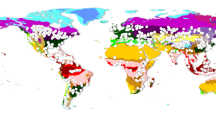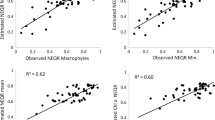Abstract
A classification system is often used to reduce the number of different ecosystem types that governmental agencies are charged with monitoring and managing. We compare the ability of several different hydrogeomorphic (HGM)—based classifications to group lakes for water chemistry/clarity. We ask: (1) Which approach to lake classification is most successful at classifying lakes for similar water chemistry/clarity? (2) Which HGM features are most strongly related to the lake classes? and, (3) Can a single classification successfully classify lakes for all of the water chemistry/clarity variables examined? We use univariate and multivariate classification and regression tree (CART and MvCART) analysis of HGM features to classify alkalinity, water color, Secchi, total nitrogen, total phosphorus, and chlorophyll a from 151 minimally disturbed lakes in Michigan USA. We developed two MvCART models overall and two CART models for each water chemistry/clarity variable, in each case comparing: local HGM characteristics alone and local HGM characteristics combined with regionalizations and landscape position. The combined CART models had the highest strength of evidence (ωi range 0.92–1.00) and maximized within class homogeneity (ICC range 36–66%) for all water chemistry/clarity variables except water color and chlorophyll a. Because the most successful single classification was on average 20% less successful in classifying other water chemistry/clarity variables, we found that no single classification captures variability for all lake responses tested. Therefore, we suggest that the most successful classification (1) is specific to individual response variables, and (2) incorporates information from multiple spatial scales (regionalization and local HGM variables).




Similar content being viewed by others
References
Albert DA (1995) Regional landscape ecosystems of Michigan, Minnesota, and Wisconsin: a working map and classification. USDA Forest Service North Central Forest Experiment Station General Technical Report NC-178
Bailey RG, Avers PE, King T, McNab WH (1994) Ecoregions and subregions of the United States (map), scale 1:7,500,000 (supplementary table of map unit descriptions compiled and edited by McNab WH and Bailey RG). U.S. Department of Agriculture Forest Service, Washington, DC
Breiman L, Friedman JH, Olshen RA, Stone CJ (1984) Classification and regression trees. Chapman and Hall, New York
Brett MT, Benjamin MM (2008) A review and reassessment of lake phosphorus retention and the nutrient loading concept. Freshwater Biology 53:194–211
Brinson MM (1993) A hydrogeomorphic classification for wetlands. Technical report WRPDE-4. U.S. Army Corps of Engineers, Waterways Experiment Station, Wetlands Research Program, Washington, DC, USA
Bryan BA (2006) Synergistic techniques for better understanding and classifying the environmental structure of landscapes. Environmental Management 37:126–140
Burnham KP, Anderson DR (2002) Model selection and multimodel inference: a practical-theoretic approach, 2nd edn. Springer, Verlag
Canham CD, Pace ML, Papaik MJ, Primack AGB, Roy KM, Maranger RJ, Curran RP, Spada DM (2004) A spatially explicit watershed-scale analysis of dissolved organic carbon in Adirondack lakes. Ecological Applications 14:839–854
Cheruvelil KS, Soranno PA, Bremigan MT, Wagner T, Martin SL (2008) Grouping lakes for water quality assessment and monitoring: the roles of regionalization and spatial scale. Environmental Management 41:425–440
D’Arcy P, Carignan R (1997) Influence of catchment topography on water chemistry in southeastern Québec Shield lakes. Canadian Journal of Fisheries and Aquatic Sciences 54:2215–2227
De’ath G (2002) Multivariate regression trees: a new technique for modeling species-environment relationships. Ecology 83:1105–1117
De’ath G, Fabricius KE (2000) Classification and regression trees: a powerful yet simple technique for ecological data analysis. Ecology 81:3178–3192
Detenbeck NE, Johnston CA, Niemi GJ (1993) Wetland effects on lake water quality in the Minneapolis/St. Paul metropolitan area. Landscape Ecology 8:39–61
Dillon PJ, Molot LA, Scheider WA (1991) Phosphorus and nitrogen export from forested stream catchments in Central Ontario. Journal of Environmental Quality 20:857–864
Donner A, Koval JJ (1980) The estimation of intraclass correlation in the analysis of family data. Biometrics 36:19–25
Emmons EE, Jennings MJ, Edwards C (1999) An alternative classification method for northern Wisconsin lakes. Canadian Journal of Fisheries and Aquatic Sciences 56:661–669
Fee EJ (1979) A relation between lake morphometry and primary productivity and its use in interpreting whole-lake eutrophication experiments. Limnology and Oceanography 24:401–416
Frissell CA, Liss WJ, Warreb CE, Hurley MD (1986) A hierarchical framework for stream habitat classification: Viewing streams in a watershed context. Environmental Management 10:199–214
Gebert WA, Graczyk DJ, Krug WR (1987) Average annual runoff in the United States, 1951-80: U.S. Geological Survey Hydrologic Investigations Atlas HA-710, scale 1:7,500,000
Gergel SE, Turner MG, Kratz TK (1999) Dissolved organic carbon as an indicator of the scale of watershed influence on lakes and rivers. Ecological Applications 9:1377–1390
Goransson E, Johnson RK, Wilander A (2004) Representativity of a mid-lake surface water chemistry sample. Environmental Monitoring and Assessment 95:221–238
Griffith GE, Kinney AJ, Omernik JM (1987) Interpreting patterns of lake alkalinity in the Upper Midwest Region USA. Lake and Reservoir Management 3:329–336
Hakanson L (1996) Predicting important lake habitat variables from maps using modern modelling tools. Canadian Journal of Fisheries and Aquatic Sciences 53:364–382
Hakanson L (2005) The importance of lake morphometry and catchment characteristics in limnology–ranking based on statistical analyses. Hydrobiologia 541:117–137
Halsey LA, Vitt DH, Trew DO (1997) Influence of peatlands on the acidity of lakes in northeastern Alberta, Canada. Water, Air, and Soil pollution 96:17–38
Higgins JV, Bryer MT, Khoury ML, Fitzhugh TW (2005) A freshwater classification approach for biodiversity conservation planning. Conservation Biology 19:432–445
Host GE, Polzer PL, Mladenoff DJ, White MA, Crow TR (1996) A quantitative approach to developing regional ecosystem classifications. Ecological Applications 6:608–618
Jenerette GD, Lee J, Waller DW, Carlson RE (2002) Multivariate analysis of the ecoregion delineation for aquatic systems. Environmental Management 29:67–75
Johnson LB, Gage SH (1997) Landscape approaches to the analysis of aquatic ecosystems. Freshwater Biology 37:113–132
Johnson JB, Omland KS (2004) Model selection in ecology and evolution. Trends in Ecology & Evolution 19:101–108
Kratz TK, Webster KE, Bowser CJ, Magnuson JJ, Benson BJ (1997) The influence of landscape position on lakes in northern Wisconsin. Freshwater Biology 37:209–217
Kunst C, Monti E, Perez H, Godoy J (2005) Assessment of the rangelands of southwestern Santiago del Estero, Argentina, for grazing management and research. Journal of Environmental Management 80:248–265
Martin SL, Soranno PA (2006) Lake landscape position: Relationships to hydrologic connectivity and landscape features. Limnology and Oceanography 51:801–814
Momen B, Zehr JP (1998) Watershed classification by discriminant analyses of lakewater-chemistry and terrestrial characteristics. Ecological Applications 8:497–507
Mora F, Iverson L (2002) A spatially constrained ecological classification: rationale, methodology and implementation. Plant Ecology 158:153–169
Moss B, Johnes P, Phillips G (1994) August Thienemann and Loch Lomond — an approach to the design of a system for monitoring the state of north-temperate standing waters. Hydrobiologia 290:1–12
Olden JD, Jackson DA (2002) A comparison of statistical approaches for modeling fish species distributions. Freshwater Biology 47:1976–1995
Omernik JM (1987) Ecoregions of the conterminous United States. Annals of the Association of American Geographers 77:118–125
Omernik JM, Kinney AJ (1983) An improved technique for estimating mean depth of lakes. Water Research 17:1603–1607
Pitblado JR, Keller W, Conroy NI (1980) A classification and description of some northeastern Ontario lakes influenced by acid precipitation. Journal of Great Lakes Research 6:247–257
Prepas EE, Planas D, Gibson JJ, Vitt DH, Prowse TD, Dinsmore WP, Halsey LA, McEachern PM, Paquet S, Scrimgeour GJ, Tonn WM, Paszkowski CA, Wolfstein K (2001) Landscape variables influencing nutrients and phytoplankton communities in Boreal Plain lakes of northern Alberta: A comparison of wetland- and upland-dominated catchments. Canadian Journal of Fisheries and Aquatic Sciences 58:1286–1299
Pyne MI, Rader RB, Christensen WF (2007) Predicting local biological characteristics in streams: a comparison of landscape classifications. Freshwater Biology 52:1302–1321
Quinlan R, Paterson AM, Hall RI, Dillon PJ, Wilkinson AN, Cumming BF, Douglas MSV, Smol JP (2003) A landscape approach to examining spatial patterns of limnological variables and long-term environmental change in a southern Canadian lake district. Freshwater Biology 48:1676–1697
R Development Core Team (2008) R: a language and environment for statistical computing. R Foundation for statistical computing, Vienna, Austria
Rasmussen JB, Godbout L, Schallenberg M (1989) The humic content of lake water and its relationship to watershed and lake morphometry. Limnology and Oceanography 34:1336–1343
Riera JL, Magnuson JJ, Kratz TK, Webster KE (2000) A geomorphic template for the analysis of lake districts applied to the Northern Highland Lake District, Wisconsin, USA. Freshwater Biology 43:301–318
Robertson DM, Saad DA, Heisey DM (2006) A regional classification scheme for estimating reference water quality in streams using land-use-adjusted spatial regression-tree analysis. Environmental Management 37:209–229
Rodgers K (2005) Evaluation of nearshore coral reef condition and identification of indicators in the main Hawaiian islands. PhD Dissertation, University of Hawaii
Seaber, PR, Kapinos FP, Knapp GL (1987) Hydrologic Unit Map, USGS Water-Supply Paper 2294
Seelbach PW, Wiley M, Kotanchik JC, and Baker (1997) A landscape-based ecological classification system for river valley segments in Lower Michigan (MI-VSEC version 1.0). Michigan Department of Natural Resources Fisheries Division, Fisheries Research Report 2036
Soranno PA, Cheruvelil KS, Stevenson RJ, Rollins SL, Holden SW, Heaton S, Torng E (2008) A framework for developing ecosystem-specific nutrient criteria: integrating biological thresholds with predictive modeling. Limnology and Oceanography 53:773–787
Stendera S, Johnson RK (2006) Multiscale drivers of water chemistry of boreal lakes and streams. Environmental Management 38:760–770
Stoddard JL, Larsen DP, Hawkins CP, Johnson RK, Norris RH (2006) Setting expectations for the ecological condition of streams: The concept of reference condition. Ecological Applications 16:1267–1276
Strayer DL, Beighley RE, Thompson LC, Brooks S, Nilsson C, Pinay G, Naiman RJ (2003) Effects of land cover on stream ecosystems: roles of empirical models and scaling issues. Ecosystems 6:407–423
Venables WN, Ripley BD (1999) Modern applied statistics with S-PLUS, 3rd edn. Springer, New York
Vidon PGF, Hill AR (2004) Landscape controls on the hydrology of stream riparian zones. Journal of Hydrology 292:210–228
Vollenweider RA (1968) The scientific basis of lake eutrophication, with particular reference to phosphorus and nitrogen as eutrophication factors. Technical Report DAS/DSI/68.27, OECD, Paris
Webster KE, Soranno PA, Cheruvelil KS, Bremigan MT, Downing JA, Vaux PD, Asplund TR, Bacon LC, Connor J (2008) An empirical evaluation of the nutrient-color paradigm for lakes. Limnology and Oceanography 53:1137–1148
Wetzel RG, Likens GE (2000) Limnological analyses, 3rd edn. Springer, New York
Winter TC (1977) Classification of the hydrologic settings of lakes in the north-central United States. Water Resources Research 13:753–767
Winter TC (2001) The concept of hydrologic landscapes. Journal of the American Water Resources Association 37:335–349
Wolock DM, Hornberger GM, Beven KJ, Campbell WG (1989) The relationship of catchment topography and soil hydraulic characteristics to lake alkalinity in the northeastern United States. Water Resources Research 25:829–837
Wolock DM, Winter TC, McMahon G (2004) Delineation and evaluation of hydrologic-landscape regions in the United States using geographic information system tools and multivariate statistical analyses. Environmental Management 34:S71–S88
Young TC, Stoddard JL (1996) The Temporally Integrated Monitoring of Ecosystems (TIME) project design 1. Classification of northeast lakes using a combination of geographic, hydrogeochemical, and multivariate techniques. Water Resources Research 32(8):2517–2528
Zimmerman AP, Noble KM, Gates MA, Paloheimo JE (1983) Physicochemical typologies of south-central Ontario lakes. Canadian Journal of Fisheries and Aquatic Sciences 40:1788–1803
Acknowledgments
This research was financially supported in part through a grant to P.A.S. and M.T.B. from the Michigan Department of Natural Resources Fisheries Division. We thank Michigan State University Remote Sensing and GIS Research and Outreach Services for catchment delineation and quantification of the climate variables; and thanks to Dan Hayes, Brian Maurer, and Ty Wagner for statistical guidance. Thanks to the following personnel for their contributions to the development of the landscape databases: Michael Belligan for the landscape position metric delineation, Jim Breck for the lake polygon coverage, Howard Wandell and Jim Breck for the Storet water quality database, Gary Weissman for guidance on the geology database, and Stephen Bowman, Tyler Rosa, Remy Brim, Cassie Meier, Dave Meyers and Sarah Wills for compiling and quality control of some of the databases.
We appreciate the comments and suggestions of Jim Breck, Kevin Wehrly, Dan Hayes, Brian Maurer, Jan Stevenson, and David Hyndman on earlier drafts of this manuscript.
Author information
Authors and Affiliations
Corresponding author
Rights and permissions
About this article
Cite this article
Martin, S.L., Soranno, P.A., Bremigan, M.T. et al. Comparing Hydrogeomorphic Approaches to Lake Classification. Environmental Management 48, 957–974 (2011). https://doi.org/10.1007/s00267-011-9740-2
Received:
Accepted:
Published:
Issue Date:
DOI: https://doi.org/10.1007/s00267-011-9740-2




